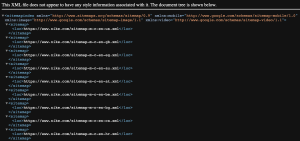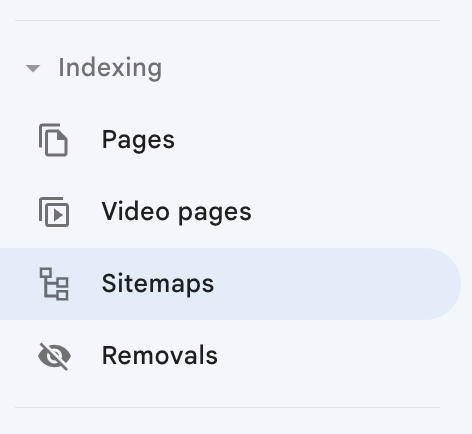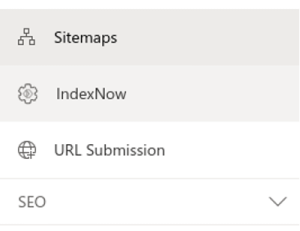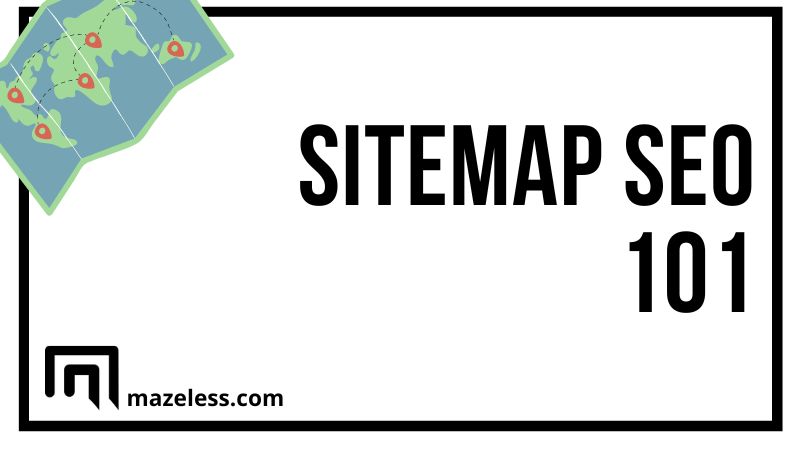Sitemaps are an integral part of search engine optimization. While they don’t get the same attention as link building or technical SEO, sitemaps are essential and valuable to every website on the Internet.
If you’re not utilizing sitemaps properly, we’re going to walk you through regular vs XML sitemaps, creating them, validating, tools to create them and more.
Contents
What are Sitemaps?
A sitemap follows the sitemap protocol, which Google and Bing adhere to, to list all of the pages on a website, or the pages on your site that you want to be followed. You can think of a sitemap as a directory of your site’s pages.
However, you can include numerous items in the sitemap, including:
- Files
- Pages
- Videos
Your site’s sitemap is a blueprint to help search engine crawlers crawl and find pages on your site. Your file also includes data, such as:
- Last modified
- Images on a page
You don’t need to learn how to write a Google XML sitemap by hand because there are tools that can help you. However, knowing what goes into the file and even seeing a sitemap example will help you better understand these files and how they work.
But before going into that, let’s answer two important questions: why are sitemaps important and why do we put so much focus on them from an SEO standpoint?
Why Are Sitemaps Important?
Sitemaps may seem like a simple file that adds a little extra work to optimize your site, but they help with a few things:
- Helps search engines find your pages
- Improves the crawlability of your site
When you have a larger site, XML sitemaps help search engines find pages faster and more efficiently. Bots may be able to find these pages on their own, but sitemaps leave nothing to chance by pointing crawlers directly to important pages, media and other files.
If you have a massive site, such as an enterprise site, or are having issues getting your pages indexed, sitemaps can help.
What are the Different Types of Sitemaps: Regular vs XML Sitemaps
You’ll find a few different types of sitemaps, each with the goal of helping crawl bots find pages and files on your site. The two main types that people talk of are:
- HTML sitemaps
- XML sitemaps
HTML Sitemaps
HTML sitemaps can often be found in the footer of a website, and they’re made using HTML.
While an HTML sitemap may be crawled by search engines, its main goal is to help visitors find your most important pages and categories.
If you have tens of thousands of pages in an XML sitemap, you certainly wouldn’t add them to your HTML sitemap because it’s information overload for your visitors. Visitors just want an easy way to find crucial pages on your site, and this is where HTML sitemaps truly make their impact.
XML Sitemaps
XML is used to generate sitemaps that web crawlers can use to learn about your site’s many files, video, and pages. These pages may be viewed by visitors, but the main purpose of these files is for search bots to find and crawl them.
Additionally, you can submit a Bing or Google XML sitemap to nudge these search bots to crawl these files.
You can view a sitemap.xml example below:

Creating Your Sitemaps
You can use a sitemap generator to make a sitemap, or you can make a sitemap manually if you have just a few pages. We recommend that you follow Google’s recommendations to build a sitemap.
Creating a sitemap manually requires you to open Notepad or something similar and add in the following:
<?xml version="1.0" encoding="UTF-8"?>
<urlset xmlns="http://www.sitemaps.org/schemas/sitemap/0.9">
<url>
<loc>https://EXAMPLE.com/</loc>
<lastmod>2023-08-21T00:00:00+03:00</lastmod>
</url>
<url>
<loc>https://EXAMPLE.com/blog</loc>
<lastmod>2023-08-21T00:00:00+03:00</lastmod>
</url>
</urlset>
You’ll simply change the URL to your own and add more <url>… </url> for additional pages. But when your site grows, this is a tedious and redundant process that is exhausting to manage with any sense of accuracy.
Instead, we recommend using tools or plugins to create your sitemap.
Tools and Plugins for Creating Sitemaps
Sitemaps are so integral to a site’s basic SEO that you’ll find many tools to help create them. We’re going to cover regular tools that will work on all websites as well as sitemap plugins for WordPress.
However, you can find plugins for virtually every CMS that will help generate a sitemap for you.
General Tools to Create Sitemaps
A few tools, both free and paid, can help you generate sitemaps on any site, including:
And if you use WordPress, you can use the recommendations below.
Sitemap Tools for WordPress
WordPress’ 5.5 Core Update has a standard sitemap generation tool built into it. However, a few plugins to consider using are:
Once you’ve made your sitemap, there’s one more step before submitting it: validating your sitemap. The file must be made properly, following all of the appropriate XML structures to be read by search engines.
How to Validate Your Sitemaps
Validating your sitemap is easiest if you use a tool for the validation, such as:
- XML Sitemaps
- org database
- Tons of others
You’ll find multiple tools that validate your XML. SEO tools often allow you to validate your sitemap if you have an account.
What to Do If Your Sitemap is Too Big
Search crawlers will analyze sitemaps that are up to 50MB in size. If the file is any larger, it’s best to split the file into multiple ones because the file size is too large to analyze. A sitemap can link to sitemaps.
For example, you can have:
- Sitemap 1
- Sitemap 1 links to Sitemap 2
- Sitemap 1 links to Sitemap 3
- Sitemap 1 links to Sitemap 4
You can do this using the following coding:
<?xml version="1.0" encoding="UTF-8"?>
<sitemapindex xmlns="http://www.sitemaps.org/schemas/sitemap/0.9">
<sitemap>
<loc>http://www.example.com/sitemap1.xml.gz</loc>
</sitemap>
<sitemap>
<loc>http://www.example.com/sitemap2.xml.gz</loc>
</sitemap>
<sitemap>
<loc>http://www.example.com/sitemap3.xml.gz</loc>
</sitemap>
<sitemap>
<loc>http://www.example.com/sitemap4.xml.gz</loc>
</sitemap>
</sitemapindex>
Google recommends the following for large sitemaps:
Every type of format sets a constraint on a single sitemap to either 50MB (prior to compression) or to 50,000 URLs. Should you possess a file larger than these specifications or have more URLs, your sitemap will need to be divided into numerous sitemaps. A sitemap index file can optionally be created and submitted to Google as a single file. Google also allows the submission of multiple sitemaps and sitemap index files.
This approach could be beneficial if you aim to monitor the search performance of each sitemap individually using the Search Console.
Reference a Sitemap XML in Your Robots.txt
Inside of your Robots.txt file, you can add a link to your sitemap. Simply copy the URL where the sitemap is located, open up your Robots.txt file and then add in the following line of code at the bottom: Sitemap: http://www.example.com/sitemap.xml.
You can also add in multiple Sitemap files if you like.
Submitting Your Sitemap to Google and Bing
Submitting your sitemap to Google and Bing is the first thing you should do once you create the sitemap. Use the guides we’ve created below to make submitting these files simple and easy.
How to submit a sitemap to Google
Google allows you to submit a sitemap directly to have their search bots crawl your website. First, you’ll want to make sure that you have a Google Search Console account and have verified your site.
Your account is free and takes just a few minutes to set up.
From here, you’ll want to click on the hamburger icon, and under Index, you’ll see Sitemaps listed.

Once you click on the Sitemaps section, you’ll need to put the URL where your sitemap is located. Often, the sitemap is located at example.com/sitemap.xml, but you’ll need to swap out the URL for your own.

Then, just click submit, and Google will take care of the rest of the process. You’ll want to take note that the sitemap file will show a status next to it once it’s submitted, and if there are any issues, you’ll need to correct them and resubmit it to Google.
You only need to submit this file once, and Google will scour the file for additional URLs.
How to submit a sitemap to Bing
Bing is another major search engine, even if fewer people use it than Google. Bing Webmaster Tools is also free and provides a lot of great insights into your site and how Bing utilizes it.
If you use Google Search Console, you can even verify your site on Bing through it, which is really nice for creating an account quickly.
From here, you’ll want to do the following:
- Click on the hamburger icon
- Click on sitemaps

Now, you’ll see that there’s a “Submit sitemap” button on the top right of the page. You’ll want to click this button and then enter in the sitemap just like you did with Google.
![]()
You’ll need to submit your file in one of the following formats, but we do recommend XML simply because it’s used most often:
- XML
- RSS 2.0
- mRSS
- Atom 0.3
- Atom 1.0
- Text files
Once submitted, you’ll notice that the sitemap’s status is Processing. Check on the file in an hour or so to ensure that there are no errors. However, if you want to skip most of this work, you can set up your Google Search Console account first and link your sitemap.
When you import all of your site’s data from Google to Bing, the sitemaps will also copy over and enter into the processing status on their own.
Sitemap FAQs
What is a sitemap?
A sitemap is a simple file that lists all of the pages, files and videos on your site that you want to be crawled by search engines.
How to create a sitemap?
You can create a sitemap in two main ways:
- Manually
- Automatically
We only recommend manually creating a sitemap if you have a very small site with less than a dozen items.
How to create a sitemap in WordPress?
WordPress has so many plugins, which we’ve listed above, that can help you generate a sitemap. Yoast is one of the most popular and reliable options for generating a sitemap. If you want to create a sitemap manually, you can create the file and then upload it to your site’s server.
WordPress also added in its own XML sitemap function in version 5.5, and this is a good option if you don’t want too much control over the file.
Final Thoughts on Sitemaps
Sitemaps are a quick and easy way to help search engine bots find pages and files on your website. Crawlers usually use links on a page to find new pages, and they can only take so much time crawling your site.
If you use sitemaps following the advice above, you’ll ensure that you did everything possible to help these bots find your pages and files.



